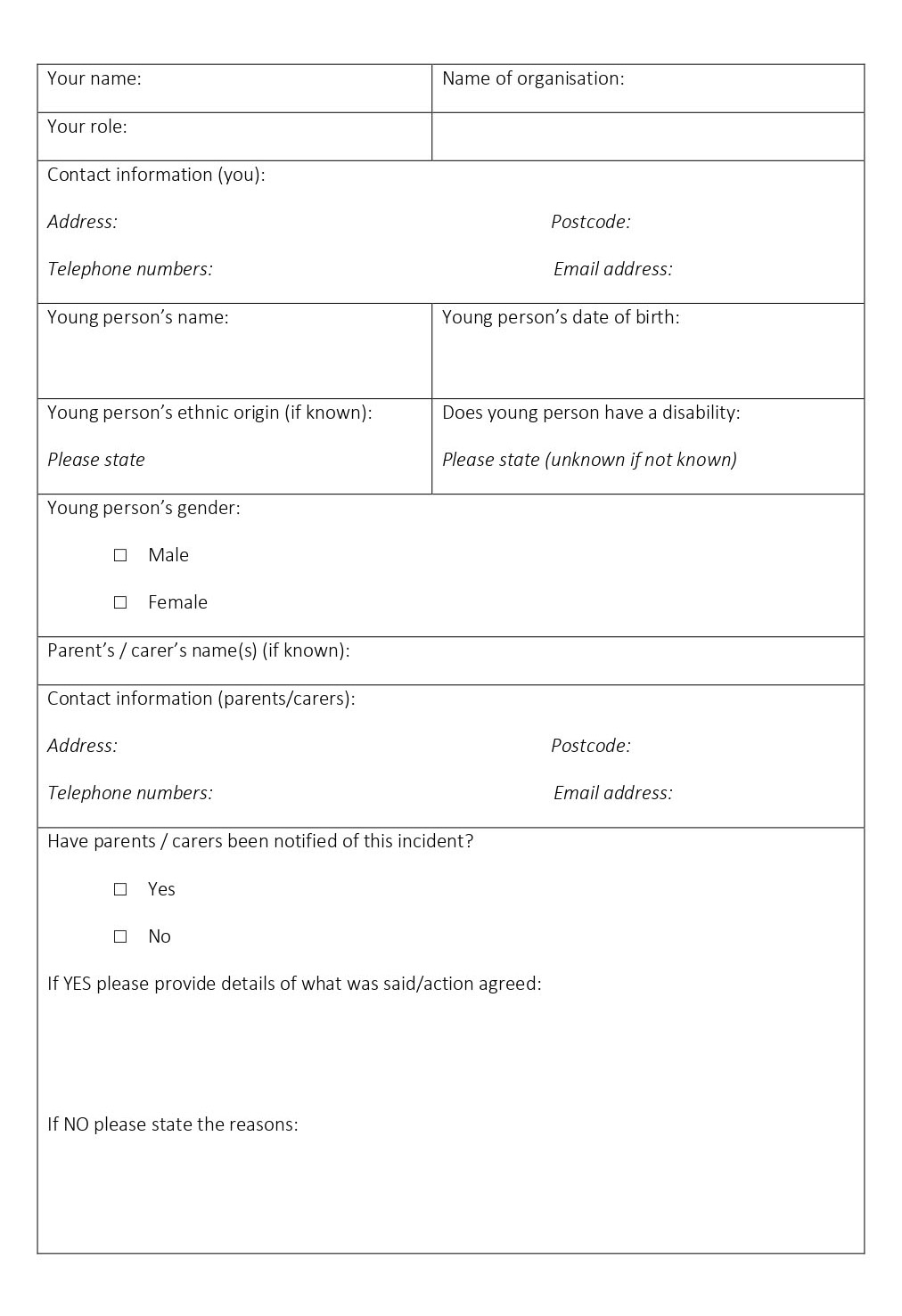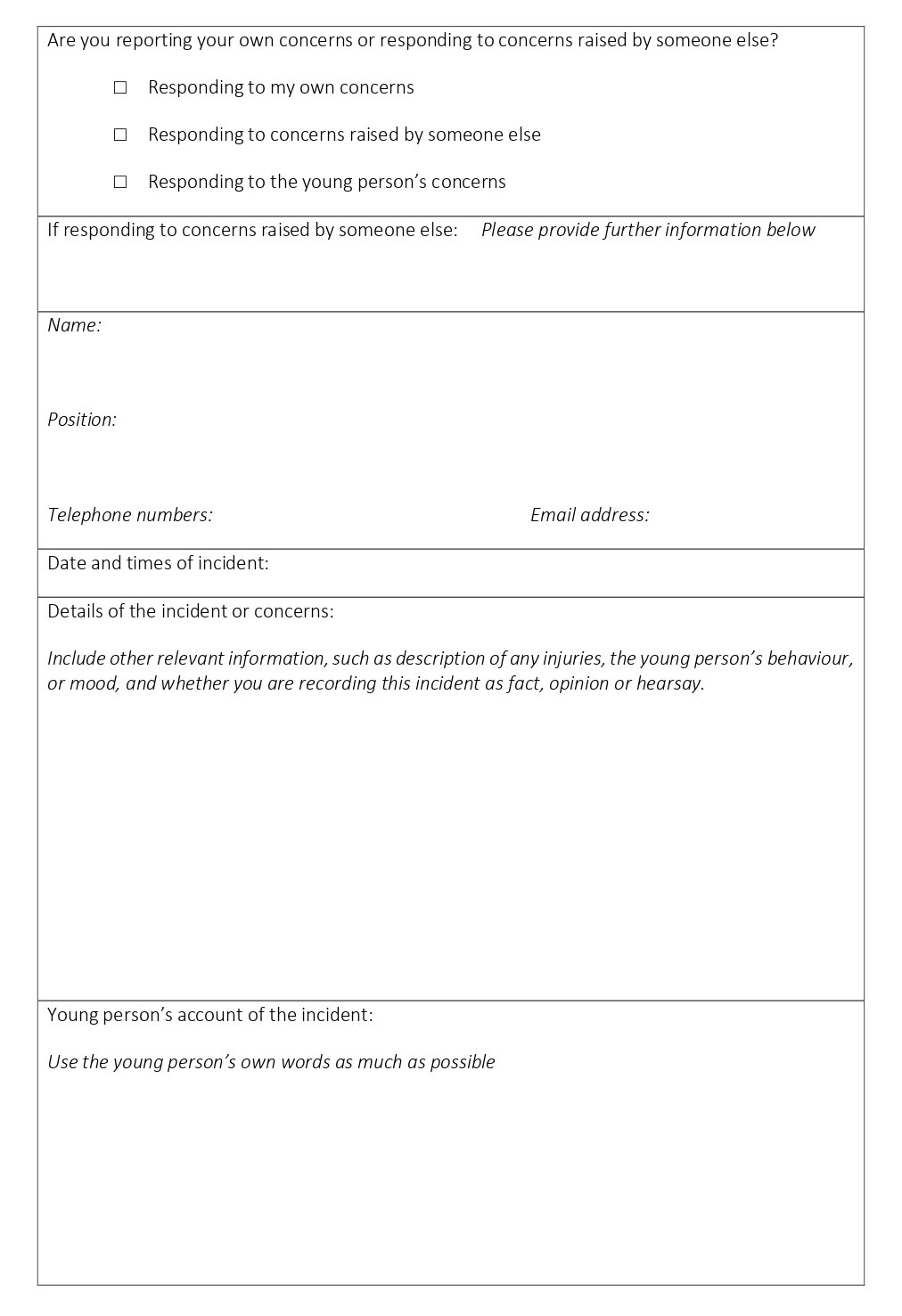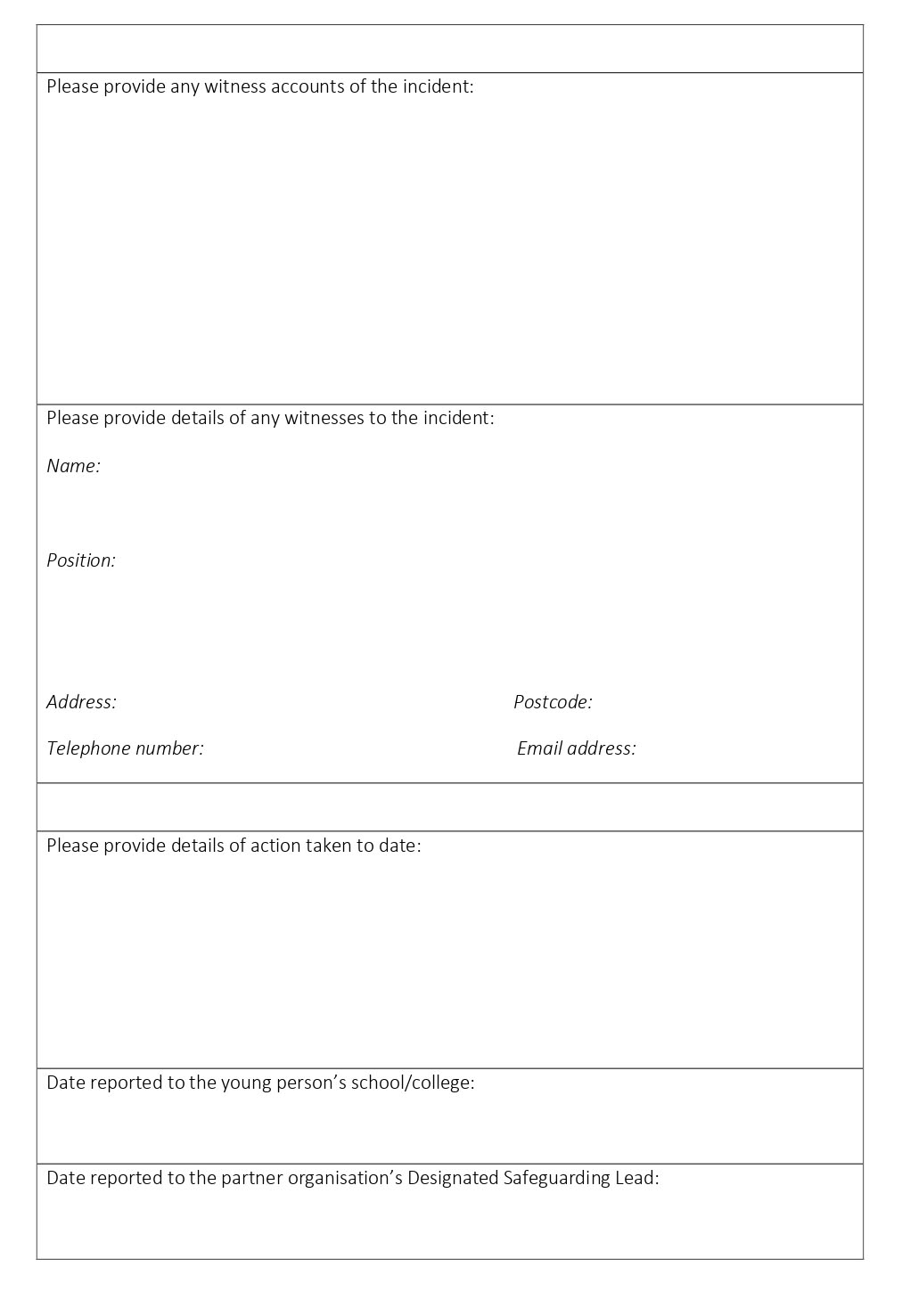Young Professionals
Safeguarding Policy & Code of Conduct
Dated January 15th, 2025
1.
INTRODUCTION
Young people have the right to be protected from harm.
Young Professionals are committed to protecting all young people that participate in our schools outreach and work experience programmes. We all have a responsibility to ensure that we promote young people’s wellbeing and protect them from harm.
2.
POLICY STATEMENT
We recognise that:
2.1
The welfare of young people is paramount. Young Professionals have a collective and individual duty to ensure that all employees fulfil their responsibilities to safeguard and promote the welfare of children and adults at risk, to prevent child abuse and to report any abuse discovered or suspected. This includes employees taking complete responsibility for ensuring they adhere to this too. Safeguarding is everyone’s responsibility. Commitment to this policy is obtained through safeguarding centric recruitment, a robust safeguarding induction plan, closely monitored safeguarding training, reporting lead by Young Professionals, safeguarding promotion by all staff members in all meetings and regular updates within Young Professionals business. Young Professionals employee recruitment procedures make specific reference to the role and responsibilities of all employees towards upholding the principles, policy and practice of effective safeguarding and all appointments are subject to satisfactory DBS and Enhanced DBS check.
2.2
All young people regardless of age, disability, gender, racial heritage, religious belief, sexual orientation, or identity have a right to protection from all types of harm. This includes physical abuse, emotional abuse, sexual abuse, and neglect. Those who work in positions of trust as part of our school’s engagement and work experience programmes must act with integrity and demonstrate the highest standards of behaviour and practice
3.
SCOPE
This policy applies to:
3.1
All staff and volunteers including Young Professionals schools’ ambassadors who are involved in arranging, co-ordinating, supervising and delivering tasks and activities as part of our outreach and work experience opportunities.
All staff and volunteers from partner organisations we work with to deliver our work experience.
4.
DEFINITIONS
“A child” is someone under the age of eighteen. We will refer to young people throughout this policy, by which we mean anyone under the age of eighteen.
“Safeguarding” is the action that is taken to promote the welfare of young people and protect them from harm.
“Child protection” is part of the safeguarding process. This includes child protection procedures which detail how to respond to concerns about a young person.
5.
LEGISLATION AND GUIDANCE
5.1
England
- (a) The Children Act 1989 provides the legislative framework for child protection in England. Key principles established by the Act include:
- (i) the paramount nature of the child’s welfare
- (ii) the expectations and requirements around duties of care to children
- (b) Working Together to Safeguard Children (2018) is the key statutory guidance for anyone working with children in England.
Keeping Children Safe in Education (2020) is the key statutory guidance for schools and colleges.
5.2
Scotland
- (a) The Children (Scotland) Act 1995 outlines the legislative framework for Scotland’s child protection system covering parental responsibilities and rights and the duties and powers local public authorities have for supporting and promoting the safety and welfare of children.
- Getting it right for every child (GIRFEC) (Scottish Government, 2018) is the Scottish Government’s approach to making a positive difference for all children and young people in Scotland.
5.3
Northern Ireland
- (a) The legislative framework for Northern Ireland’s child protection system is set out in The Children (Northern Ireland) Order 1995. This sets out parental responsibilities and rights and the duties and powers public authorities must support children.
- Revised regional core child protection policies and procedures for Northern Ireland (Safeguarding Board for Northern Ireland, 2018) explains the actions that must be taken when there are concerns about the welfare of a child/young person.
6.
CHILD PROTECTION PROCEDURES (SEE PROCEDURES DOCUMENT BELOW)
We will seek to keep young people safe by:
(a) Listening to, valuing, and respecting them
(b) Having a designated safeguarding lead
(c) Having safeguarding procedures which adopt best practice
(d) Recruiting and selecting staff and volunteers safely, ensuring all necessary checks are made
(e) Recording, storing, and using information professionally and securely, in line with data protection legislation and guidance
(f) Ensuring all staff and volunteers know how to raise a concern
(g) Raising awareness of safeguarding amongst our workforce
(h) Having a code of conduct for staff and volunteers
(i) Making sure young people know where to go for help if they have a concern
(j) Sharing concerns appropriately with relevant agencies
(k) Managing allegations against staff appropriately
- Creating and maintaining an anti-bullying environment and ensuring that we have a policy and procedure to help us deal effectively with any bullying that does arise – see procedures below
- Ensuring that we have effective complaints and whistleblowing measures in place
- Providing a safe physical environment for young people, staff, and volunteers, by applying health and safety measures in accordance with the law and regulatory guidance
- Promoting a culture where staff and volunteers and young people treat each other with respect and are comfortable about sharing concerns.
7.
CONTACT DETAILS
The Designated Safeguarding Lead at Young Professionals is:
Daniel Miller, CEO & Co-founder
dan.miller@young-professionals.uk
In his/her absence, contact:
Kav Sandhu
kav.sandhu@young-professionals.uk
NSPCC
You can contact the NSPCC Helpline on 0808 800 5000 or email help@nspcc.org.uk
CHILDLINE
You can contact on Childline 0800 1111
We are committed to reviewing this policy annually.
This policy was last reviewed on January 15th, 2025
Signed Daniel Miller – Designated Safeguarding Lead
8.
CHILD PROTECTION PROCEDURES
8.1
8.1 Designated Safeguarding Lead responsibilities:
- (a) To take the lead role in ensuring that arrangements are in place for keeping young people safe at Young Professionals work experience programs.
- (b) How to identify the signs and symptoms of abuse and when to make a referral
- (c) The local child and adult at risk protection procedures and the DSL’s role within them
- (d) The role and responsibilities of the investigating agencies and how to liaise with them
- (e) The requirements of record keeping
The conduct of a child protection conference* and how the DSL or other employees can make an appropriate contribution to it.
-
Developing and reviewing Young Professionals safeguarding and child protection policies and procedures.
- (i) Implementing Young Professionals safeguarding and child protection policies and procedures.
-
Ensuring all safeguarding and child protection issues concerning children and young people who take part in Young Professionals events and work experience programs at Young Professionals are responded to appropriately.
- (ii) Making sure that everyone working or volunteering with young people at Young Professionals understands the safeguarding and child protection policy and procedures and knows what to do if they have concerns about a young person’s welfare.
-
Making sure young people on work experience at Young Professionals know who they can talk to if they have a welfare concern and understand what action the organisation will take in response.
- (iii) Receiving and reporting information from anyone who has concerns about a young person taking part in work experience.
-
Taking the lead on responding to information that may constitute a child protection concern, including a concern that an adult involved with Young Professionals may present a risk to young people. This includes:
- (A) assessing and clarifying the information
- (B) making referrals to statutory organisations as appropriate
- (C) consulting with and informing the relevant members of the organisation’s management
- (D) following the organisation’s safeguarding policy and procedures.
-
Liaise with, pass on information to and receive information from statutory child protection agencies such as the local authority child protection services and the police. This includes making formal referrals to agencies when necessary.
Informing partner organisations of any safeguarding concerns arising from work experience.
- (iv) Storing child protection records following Data Protection principles. See guidance here.
-
Attending regular training in issues relevant to child protection and share knowledge from that training with everyone who works or volunteers with or for young people at Young Professionals. It is recommended that the following training is undertaken:
- (A) England
- (B) Northern Ireland
- (C) Scotland
- (f) All staff and volunteers involved in work experience have a responsibility to:
- (i) Be familiar with the Safeguarding and Child Protection Policy and Procedures
- Know how to report a concern about a young person to the Designated Safeguarding Lead at Young Professionals.
- (g) Young people on work experience should:
- (i) Know who the Designated Safeguarding Lead is at Young Professionals
-
Know how to report a concern
(ii) Be provided with an information booklet that includes the above information
9.
RECOGNISING AND RESPONDING TO ABUSE
9.1
Assessing Risk
(a) Potential risks should consider any risks to a young person’s welfare as well as any health and safety risk. This will form part of our risk assessment. We will work closely with the young person, our partner organisations and/or the young person’s school or college to complete this.
Risk factors include young people who may be vulnerable for a variety of reasons. In the context of our outreach and work experience programmes we may be working with young people who are or have been in care, those who are asylum seekers or refugees, and those who are young carers. This does not mean that all young people who are in these groups are being abused or have been abused:
- (i) Young people enter the care system for many different reasons. Many young people in the care system will have been abused or neglected. Most young people in the care system are in foster care. The main reason for young people leaving care is to return to their families.
- Young people who are refugees or asylum seekers may have experienced trauma or stress. Moving to a new country can mean a lack of family or social networks. Young people may have fears about the right to remain in the UK. Some young people may have been trafficked into the country and have been separated from family members.
- (ii) Young carers face additional challenges at home and at school. They are one and half times more likely to have a special educational need or disability. School attendance can be impacted by caring responsibilities.
9.2
Induction
As part of a young person’s induction for a work experience or mentorship programme they should be given a copy of this policy and procedures and introduced to the safeguarding lead for child protection.
9.3
Identifying a concern
Young people may disclose abuse in a variety of ways:
(a) Directly– making specific verbal statements about what’s happened to them
Indirectly – making ambiguous verbal statements which suggest something is wrong
(b) Behaviourally – displaying behaviour that signals something is wrong (this may or may not be deliberate)
Non-verbally – writing letters, drawing pictures, or trying to communicate in other ways.
Young people may not always be aware that they are disclosing abuse through their actions and behaviour. Sometimes young people make partial disclosures of abuse. They may withhold some information because they are unsure about what will happen, or they feel scared, ashamed or that they are to blame.
9.4
Responding to a concern
If a young person tells you they are experiencing abuse, it’s important to reassure them that they’ve done the right thing in telling you. Make sure they know that abuse is never their fault.
Never talk to the alleged perpetrator about the young person’s disclosure. This could make things a lot worse for the young person.
Once you suspect or know of any abuse of any child or adult at risk, you should immediately inform the Safeguarding Lead within your organisation, in person or by telephone. Even if you have only heard rumours of abuse, or you have a suspicion but do not have firm evidence, you should still contact the Safeguarding Lead to discuss your concerns.
It is important to understand that your responsibilities extend to suspicion of abuse in any area of the child or adult’s life, not just at Young Professionals events and work experience programs.
You must also contact the Safeguarding Lead if you know or suspect that an employee or student has a previous history of abuse of children and/or adults at risk. If you become aware of any allegations against an employee this must always be escalated to the Safeguarding Lead
If the Safeguarding Lead is not immediately available, you should then contact the Safeguarding second chair You must not try to investigate the matter on your own. All other employees are not quipped nor qualified to do so.
9.5
Recording a concern
(a) You should make a written record of the concern and include:
- (i) the date and time of the incident/disclosure
- (ii) the date and time of the report
- (iii) your name and contact details
- (iv) the names of all parties who were involved in the incident, including any witnesses
- (v) the name, age and any other relevant information about the young person who is the subject of the concern (including information about their parents or carers and any siblings)
- (vi) what was said or done and by whom, using the young person’s words where possible
- (vii) any internal action taken to investigate the matter
- (viii) any further action taken (such as a referral being made)
- (ix) the reasons why the organisation decided not to refer those concerns to a statutory agency (if relevant).
- A form that can be used for recording concerns can be found in the resource section at the end of this policy.
It is not your responsibility, or that of the Designated Safeguarding Lead, to decide whether abuse has taken place or to investigate what happened.
What happens next?
- (x) Your Designated Safeguarding Lead for child protection will report the concern to: The Designated Safeguarding lead at the young person’s school or college as a priority,
9.6
Hearing about child abuse can be upsetting. You can get support from:
(a) Local child protection services in your area or the local authority where the young person lives
(b) NSPCC – You can contact the NSPCC Helpline on 0808 800 5000 or email help@nspcc.org.uk
(c) Samaritans – You can contact the Samaritans Helpline on 116 123 or visit their website
(d) Lifeline – In Northern Ireland you can contact the Lifeline helpline on 0808 808 8000 or visit their website
(e) Breathing Space – In Scotland you can contact the Breathing Space Helpline on 0800 83 85 87 or visit their website
If a young person discloses to you, you need to:
- Show you care, help them open up: Give your full attention to the young person and keep your body language open and encouraging. Be compassionate, be understanding and reassure them their feelings are important.
Take your time, slow down: Respect pauses and don’t interrupt the young person – let them go at their own pace.
- Show you understand, reflect: Make it clear you’re interested in what the young person is telling you. Reflect what they’ve said to check your understanding – and use their language to show it’s their experience
9.7
Reporting a concern
Some useful flowcharts can be found in the resource section at the end of this policy.
• In an emergency or if the young person is in immediate danger, call 999 immediately.
If the young person is not in immediate danger:
• Report your concern to the Designated Safeguarding Lead (Dan Miller) as soon as possible following the procedures below.
9.8
Information Sharing and Consent
Information sharing is a key part of safeguarding young people. You must always have a clear and legitimate purpose for sharing a young person’s personal information. Keep a record of the reasons why you are sharing or requesting information about a young person or their family.
You should also make sure you are not putting a young person’s safety and wellbeing at risk by sharing information about them.
Always seek consent to share information about a young person and their family. However, if consent isn’t given, you can still share information with relevant professionals under certain circumstances, for example if you are protecting a young person from significant harm.
9.9
Child Protection Record Retention and Storage
Concerns about a young person’s welfare should be recorded as outlined above. Whether your child protection records are electronic or paper-based, they need to be kept confidential and stored securely. Electronic files should be password protected and stored on computers with protection against hackers and viruses.
9.10
Whistleblowing
You can contact the NSPCC Whistleblowing Advice Line on 0800 028 0285 or help@nspcc.org.uk
Contact the Whistleblowing Advice Line if:
(a) Concerns aren’t dealt with properly or may be covered up
A concern that was raised hasn’t been acted upon
(b) You are worried that repercussions are likely to arise if you raise a concern
9.11
Safer Recruitment of staff and volunteers who work with young people
Young Professionals takes a Safer Recruitment approach to the on-boarding of staff. This is carried out by complying with the recognised set principals and procedures. Safer recruitment is embedded with Young Professionals Recruitment practises. At Young Professionals, we are committed to recruiting staff and volunteers who are suitable to work with young people where this is a requirement of the role. We do this by:
(a) Implementing robust safer recruitment practices
Ensuring the suitability of applicants
A concern that was raised hasn’t been acted upon
(b) Responding to concerns about the suitability of applicants during the recruitment process
Responding to concerns about the suitability of employees and volunteers once they have begun their role
(c) Providing an induction which includes safeguarding
Publishing information on safeguarding on our website/intranet for all staff
9.12
Vetting, Disclosure and Barring Checks
At Young Professionals, we will ensure that the Designated Safeguarding Lead and other staff or volunteers who will be working directly with young people on work experience will have a valid vetting disclosure and barring check appropriate to their role.
There are different types of criminal record checks depending on the nature of the work being carried out.
(a) England, Northern Ireland, and Wales
If someone is doing “regulated activity” they need to undergo an “enhanced with barred list check”. This provides information about police convictions, cautions, reprimands, and warnings; information about whether the person has been barred from working with children; and any other relevant information.
In England, Northern Ireland, and Wales, regulated activity with children means carrying out any of the below activities frequently or with intensity (more than 3 days in a 30-day period or overnight):
(i) Unsupervised activities: teaching, training, instructing, caring for or supervising children; providing advice/guidance on wellbeing, or driving a vehicle only for children.
Working for a limited range of “specified places” with the opportunity for contact with children and young people, for example schools, children’s homes, childcare premises.
The Disclosure and Barring Service (DBS) helps employers and voluntary organisations in England and Wales make safer recruitment decisions: www.gov.uk/government/organisations/disclosure-and-barring-service.
Access NI provides disclosure information, and the DBS carries out barring procedures for Northern Ireland: www.nidirect.gov.uk/campaigns/accessni-criminal-record-checks.
(b) Scotland
If someone is doing “regulated work” they need to undergo a Protecting Vulnerable Groups (PVG) check.
In Scotland, regulated work with children can be paid or voluntary. It usually involves:
(i) working directly with children
teaching or supervising children
(ii) providing personal services to children
caring responsibilities
Disclosure Scotland carries out criminal record checks and manages the Protecting Vulnerable Groups (PVG) scheme: www.mygov.scot/disclosure-types.
No DBS checks needed
(a) The DfE advice document on post 16 work experience explains that, as of July 2012, work experience providers are no longer required to carry out enhanced DBS checks on staff supervising young people aged 16 to 17. Existing arrangements can be used to manage risk
(b) According to DfE guidelines, liability insurance covers work experience placements. Occasionally, students will need to share this information with their schools, therefore it is important to have these documents to hand should it be requested. In addition, employers can use their existing arrangements for assessing and managing risks to young people.
9.13
Managing Allegations of Abuse Against Staff or Volunteers
Young Professionals takes any concerns raised about staff or volunteers seriously, regardless of who the person is, how long they’ve been with us, or whether they are directly employed by us.
If an allegation is made that a staff member or volunteer has:
(a) behaved in a way that has harmed or may have harmed a child.
possibly committed a criminal offence against, or related to, a child.
(b) behaved towards a child or children in a way that indicates they may pose a risk of harm to children.
behaved in a way that indicates they may not be suitable to work with children.
We will report this immediately to local child protection services, the police, or the NSPCC helpline.
If the allegation is against someone we do not employ directly, the organisation they work or volunteer for will be involved in the investigation.
9.14
Managing Allegations of Abuse Against a Young Person Involved in Work Experience or Mentoring at Young Professionals
If allegations have been made against a young person you should speak to your designated safeguarding lead to explore the best way forward.
A young person behaving inappropriately may need to be spoken to about this immediately, in order to manage the behaviour. Remember that they may not realise their behaviour is unacceptable. Talk to them calmly and explain why their behaviour is unsuitable and what they can do to improve it.
Be aware that a young person who displays challenging behaviour may be doing so because they have experienced abuse or neglect. If you think this may be the case, follow these child protection procedures.
9.15
Code of Conduct for Staff and Volunteers
Everyone at Young Professionals should know what is expected of them and feel safe, respected, and valued.
Young Professionals must make sure that everyone has seen, understood, and agreed to follow the code of conduct, and that they understand the consequences of inappropriate behaviour.
A recommended Code of Conduct can be found in the resource section at the end of this policy
9.16
Code of Conduct for outreach programme/ work experience students
We expect people who take part in our services to always display appropriate behaviour. This includes behaviour that takes place outside of Young Professionals and behaviour that takes place online.
It is recommended a Code of Conduct is included in students Induction Booklet.
9.17
Bullying
Bullying is when individuals or groups seek to harm, intimidate or coerce someone who is perceived to be vulnerable (Oxford English Dictionary, 2018). It can involve people of any age, and can happen anywhere – at home, work, school or using digital technologies (cyberbullying). This means it can happen at any time.
9.18
Bullying encompasses a range of behaviours which are often combined:
(a) Verbal abuse such as name calling or making negative remarks
Physical abuse such as hitting, pushing and physical assault
(b) Emotional abuse through making threats, excluding, or undermining another person
Cyberbullying/online bullying includes:
(a) Excluding a young person from online activities
(b) Sending threatening, upsetting or abusive messages
Creating and sharing embarrassing or malicious images or videos
(c) ‘Trolling’ – sending menacing or upsetting messages on social networks or online platforms
Encouraging young people to self-harm or engage in risky behaviours
(d) Creating fake accounts, hijacking, or stealing online identities to embarrass a young person or cause trouble using their name.
If you suspect a young person is being bullied or that they are bullying others, you should follow the procedures in Sections 5 and 6.
9.19
Online Safety and social media – Virtual Work Experience and Online Communities
Providing work experience virtually is a relatively new way of working, especially post COVID-19. It can be an engaging way to ensure young people can still participate even if they cannot attend workplaces in person. There are many considerations to think about before setting up a virtual experience. Staff and volunteers who are communicating online with young people should always:
(a) Use accounts that have been authorised by name of organisation to communicate with young people (never use personal accounts)
Turn on privacy settings on accounts that are used to interact with young people
(b) Use an organisational device to communicate with young people
Ensure all communications are relevant to the work of the project and organisation
(c) Use age-appropriate language
9.20
Online Communities
Online communities can give a wider reach and enable you to connect with more young people.
Communities can be hosted on online forums, websites, or social media. Different platforms and apps enable different benefits, such as instant messaging, personal profiles and facilities for hosting and sharing online events. But there are also risks.
You may set up a social media page for your group without the intention of establishing a community. However, once people start interacting with your page, it becomes an online community, and you have a responsibility to take steps to keep everyone who uses it safe.
Make sure the young people, staff and volunteers in your online community know who to talk to if they see or hear anything upsetting or inappropriate.
There are specific safeguarding measures that you need to consider if you run an online community:
9.21
Make sure the community is appropriate to the age of the young people who will be using it
(a) When thinking about hosting platforms, consider the age and type of community you want to establish and choose one which can be managed and maintained within the capacity of the organisation
The visibility of personal information is likely to be increased when using online platforms
(b) Ensure that privacy and security settings are enabled. More advice is available from the NSPCC advice line on 0808 800 5002
Moderation – any online community should be moderated. Participants should be made aware of what is and what is not permitted, and how and when posts will be moderated
9.22
Live streaming
Livestreaming can be used to broadcast events or activities to young people in real time, from anywhere and at any time. Young people can participate in the stream or choose to watch. Some livestreams can also be saved and kept on social media platforms to view later.
Hosting a live stream:
(a) If a young person can’t be seen in your stream there may still be identifying information such as their name, email address or a link to their social media account. Never reveal the full identity of individual participants and keep any identifying information private
Consider how to make sure your livestream only includes the people you’ve invited. For example, you might be able to ask your audience to register to watch the stream and issue a log in and password. Or you could look into using a custom platform if you regularly livestream
(b) Consider which platform to use. Some free platforms such as YouTube or Facebook Live do not allow you to restrict the audience
Be sensitive to the needs of individuals, for example those who may be sensitive to topics or issues that may arise during the livestream
(c) Make sure the platform you’re using is accessible to deaf and disabled young people. For example, you could use screen readers or subtitling
If you’re appearing in the livestream, make sure your surroundings and environment are appropriate
9.23
Photography and Sharing Images
Sharing photographs and films of activities can help to celebrate the successes and achievements of young people and provide a record of activities. We will ensure that:
(a) We obtain written consent from a young person and their parents or carers before taking and using a young person’s image
We always explaining what images will be used for, how they will be stored and what potential risks are associated with sharing images of children
(b) We make it clear that a young person or their family can withdraw consent for an image to be shared, but it may not be possible to delete images that have already been shared or published
We will change the names of young people whose images are being used in our published material whenever possible (and only using first names if we do need to identify them)
(c) We will mitigate the risks of sharing and storing images by:
(i) Storing images in a safe location
Encrypting images before they are stored
(ii) Only using devices belonging to our organisation to take and store images of young people
Approval must be sought from the Responsible Business team (Daniel Miller or Molly Houlian) before images are shared
9.24
1-2-1 Working and Supervision
Most of the time it is not necessary to work individually with a young person on work experience. However, there may be occasions whilst on mentorship programmes where it is necessary to meet individually with a young person. In these circumstances, you should:
(a) Tell another appropriate adult know you will be alone with a young person, preferably the nominated child protection lead
Arrange meetings during usual working hours
(b) Agree an agenda for the meeting and make sure the young person knows what the meeting/session is about
Meet in an open area or room with the doors open, so that you can be seen by others
(c) If working online the same general principles apply, i.e.
(i) Avoid 1-2-1 conversations online if possible; invite a co-worker to join the meeting or a safeguarding lead to observe.
Only use official organisation accounts and devices and official e mail addresses
(ii) Consider what is in the background if you are at home. Avoid conducting online sessions from your bedroom.
Always maintain professional boundaries and abide by you code of conduct
(iii) After any type of 1-2-1 session, record the date, time and place, the reason for the meeting, and a summary of the activity or discussion.
9.25
Ongoing Contact and Mentoring
You may be asked to stay in touch after the outreach programme or work experience has ended. This is acceptable if you follow the principles of this policy. In order to protect young people and yourself you should:
(a) Arrange ongoing mentoring with the knowledge of the young person’s school or college
Identify specific aims and timeframes for the contact to continue
(b) Keep contact open and make others aware of your ongoing involvement
Ensure the Designated Safeguarding Lead is aware of your ongoing involvement
(c) Be aware of your own behaviour and how best intentions can be misinterpreted by the young person and/or your colleagues. For example, avoid connecting on your personal social media accounts, meeting privately outside of working hours or premises
Make your manager aware of any issues where your behaviour could have been misinterpreted
(d) Make your manager aware of circumstances which could indicate a young person is becoming too dependent or close to you.
9.26
Code Of Conduct for Staff and Volunteers
Everyone who is covered by this policy commits to respecting, promoting, upholding, and protecting, always, the rights of the child (young person) as set out in the UN Convention on the Rights of the Child. Anyone found to be in breach of our Code of Conduct will be subject to disciplinary action which may include dismissal or termination of employment or other arrangement with us.
Everyone covered by this policy should always follow the guidelines below when interacting directly with children and young people in any capacity on behalf of Young Professionals
• Always prioritise the safety and wellbeing of the young person.
• Never take sole responsibility for a young person, if a young person needs care alert the parent or chaperone.
• Only take on practical caring responsibilities, for example, taking a young person to the toilet, in an emergency.
• Remember they are young people (children) first, and contributors or participants second.
• Never lose sight of the fact that you are with young people – behave appropriately and always use appropriate language.
• Always listen to and respect young people; don’t patronise them.
• Avoid favouritism and treat young people fairly and without prejudice or discrimination.
• Always act within professional boundaries; ensure all contact with young people is essential to the programme / event / activity / project you are working on.
• If you feel anyone is behaving inappropriately around young people, you have a duty to report your concern.
• Ensure that if any form of physical touching is required, it should be provided openly and kept to a minimum.
• Positively support a “whistle-blowing‟ culture where any concerns about inappropriate behaviour are reported and dealt with in a timely manner.
• It is not advisable to give under 18s or vulnerable adults, your personal details such as home or mobile phone number, home address or internet (IP) address or to communicate on a personal basis via social networking sites, for example, Facebook, Twitter etc. If there is a need for contact details to be shared, consider using the official channels.
• Parental consent must be obtained for activities involving under18s.
• Use of Photographic/Video Equipment. Written consent to take and use images of children should be obtained prior to the taking of photographs and/or video footage. Parents/carers should be made aware of when, where, and how the images may be used to give their informed consent.
9.27
Additional information and useful links can be found here
1. Working together to safeguard children: http://www.education.gov.uk/childrenandyoungpeople/safeguardingchildren/g00213160/working-together-to-safeguard-children
2. Training to help you make sure you’re recruiting the right staff and volunteers to work with children and young people. https://learning.nspcc.org.uk/safeguarding-child-protection/safer-recruitment
3. A guide to eligibility for criminal record checks: https://www.gov.uk/government/uploads/system/uploads/attachment_data/file/260319/DBS_guide_to_eligibility_v2.2.pdf
4. Regulated activity (adults): The definition of ‘regulated activity’ (adults) as defined by the Safeguarding Vulnerable Groups Act 2006 from 10th September 2012: https://www.gov.uk/government/uploads/system/uploads/attachment_data/file/216900/Regulated-Activity-Adults-Dec-2012.pdf
Reporting a concern – non-emergency
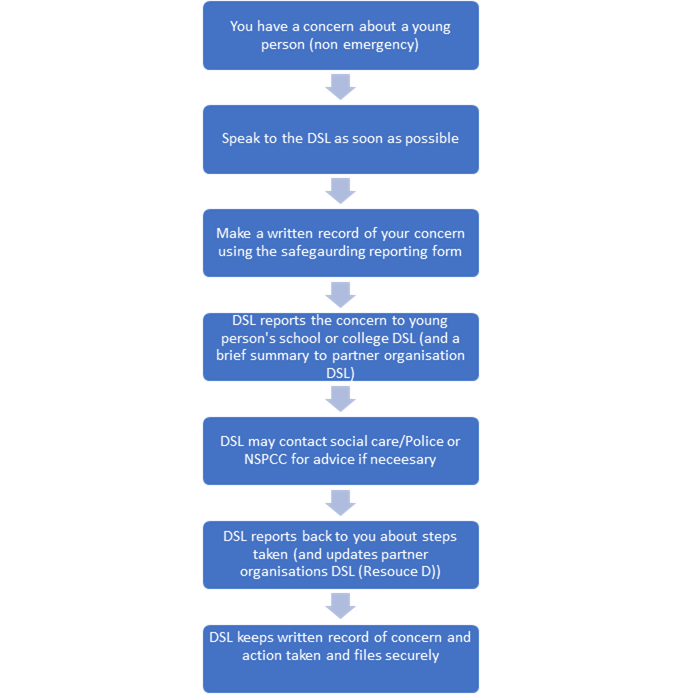
Reporting a concern – emergency
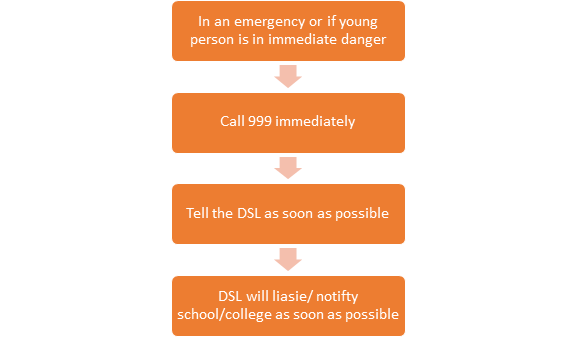
Form to complete when raising a concern
